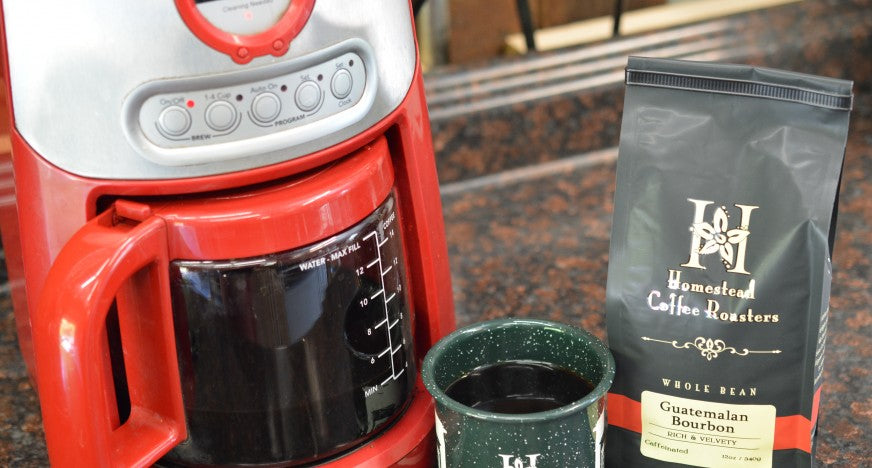Great Coffee Starts with the Beans

Fortunately for you, you’re using Homestead Coffee so you know it’s fresh! You should try to buy freshly roasted beans in small quantities regularly instead of purchasing large amounts in bulk and using them over a long period of time. This will ensure that you are harnessing all the nuanced flavors possible for your brewed coffee. A common misconception is that coffee can be stored in the freezer to preserve freshness – don’t fall for it! Keep your beans in a small, air tight container once opened and use quickly.
The Perfect Grind Size

The size of your grounds will determine extraction time. A grind too fine will result in a bitter, over-extracted taste, while a grind too course will leave you with a flat, watery cup. Most drip machines with flat bottom paper filters or reusable mesh filters work best at a medium grind, while cone filters require a slightly finer grind. Remember, each machine is different so you may find that adjusting your grind slightly can drastically improve the quality of your coffee. Also, try to grind your whole beans as close to brew time as possible. Coffee stales quickly once ground and exposed to oxygen, and you’ll be able to taste a degradation of flavor over a period of days. For the tastiest drip coffee, grind and portion immediately prior to use.
Water Quality and Temperature

Brewed coffee is primarily water, so the flavor is your water can make all the difference when making a pot of coffee. If you can, use only filtered water when brewing at home. For optimum extraction time and quality, it is suggested that you use water between 195-205 degrees Fahrenheit. Most at-home machines never reach this temperature so extraction can be slow and inconsistent, while others will heat endlessly until the brew cycle is complete, essentially burning the beans.
Pro Tip: If your coffee just never seems hot enough, run a batch of water (without an coffee) to warm up the internal components of the machine and preheat the water. Use that same water to brew your coffee. It might never reach 200 degrees, but this will help it get much closer!
The Proper Coffee to Water Ratio

As a standard rule, measure 1 heaping tablespoon of freshly ground coffee per cup of coffee as demarcated on your pot. This equates to about 3oz of coffee for an 8 cup pot. If you feel that your coffee is too strong for your liking, hold back on your scoop size. If it’s way too weak then throw in an extra tablespoon. No rule is hard and fast, and every machine is different, so be sure to experiment at home to find your perfect ratio.
Timing is Everything

It’s a Clean Machine
All these factors will be useless if your’re working with a dirty drip machine! Coffee deposits oils on surfaces like glass carafes and internal machine components. Keeping your brewer clean will make all the difference in the flavor of your morning cup. Be sure to wash your glass pot with soap and water after every use and remove and discard used filters. Letting a filter sit inside a machine can cause mildew to develop that can seriously sour your coffee. Once a month, run a brief clean cycle to flush out any oil build up that may occur by following these easy steps.
1. Measure out a 50/50 mixture of vinegar and water.
2. Run a brew cycle with this mixture (but no coffee!)
3. Repeat brew cycle with same 50/50 mixture that just flushed through your machine.
4. Scrub your pot with soap and water until squeaky clean.
5. Run fresh water (no vinegar) once more to rinse out any residue.
Enjoy!



Leave a comment
Also in News
Why We Work Exclusively With Small Farms
April 24, 2024
Continue reading
Exploring a Transforming Colombia - Comuna 13 in Medellín
April 07, 2023 2 Comments
Continue reading
2020 Thoughts and Gratitude
September 18, 2020 4 Comments
Continue reading